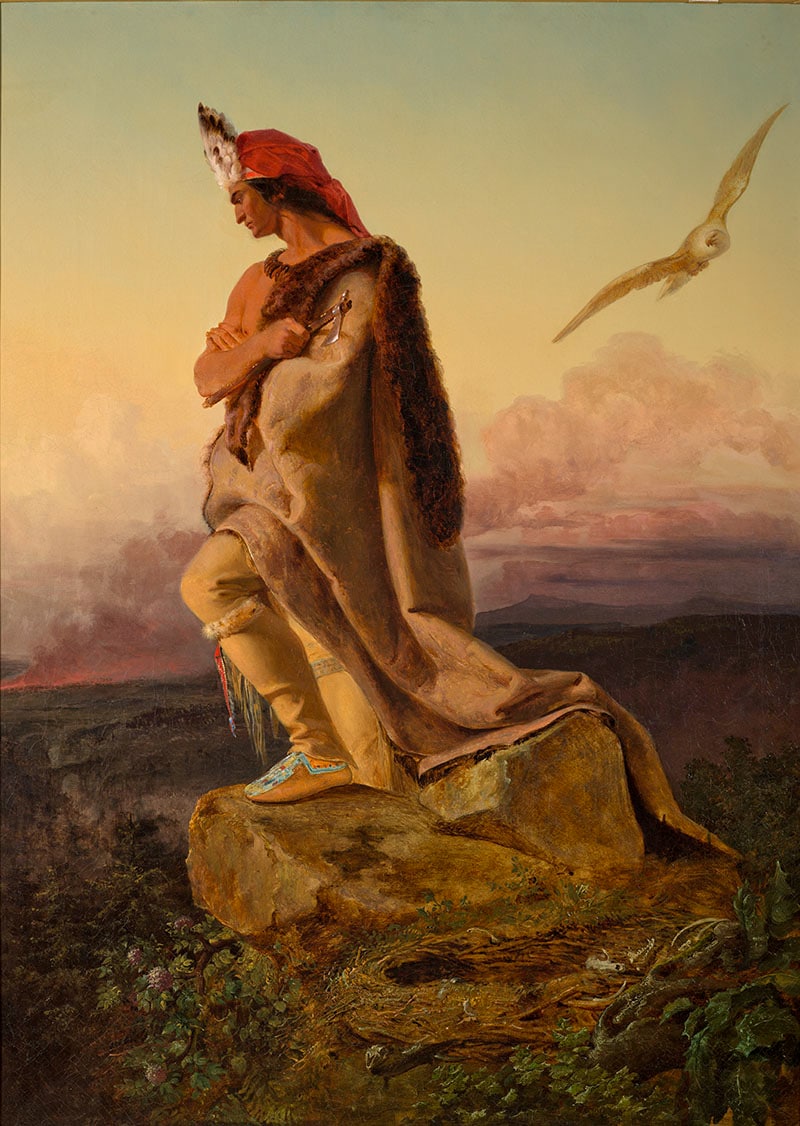Art and Literature
Emanuel Gottlieb Leutze, The Last of the Mohicans, 1850.
Background Information
For centuries, European artists had a tradition of creating grandiose artworks based on literature. Artists in United States carried on this tradition, but eventually felt the need to create artwork that celebrated the history and literary achievements of their own country. It was during this time that artists began to look toward American literature for subject matter—stories that were often based on adventures in the American West. The artwork created with narratives as inspiration often romanticized life on the frontier, and described Native American culture as rapidly coming to an end.
For example, this painting depicts a scene from James Fenimore Cooper’s The Last of the Mohicans. This book became symbolic of Euro-Americans’ perceptions of and feelings toward Native Americans at the time. From when the book was published in the 1820s through the time when Leutze painted this in 1850, Native Americans were being relocated away from their ancestral homes to the West in order to accommodate a growing Euro-American population. Many Euro-Americans at the time considered Native American cultures to be noble and traditional, and feared they were quickly becoming extinct.
Look Closer

Look carefully at the character in the painting. Observe his pose,
facial expression,
and surroundings.
Think about how the artist has composed this scene. Notice what is happening in the background,
and contemplate the artist’s inclusion of symbolic elements in his composition.
Emanuel Gottlieb Leutze, The Last of the Mohicans, 1850.
Look carefully at the character in the painting. Observe his pose1, facial expression2, and surroundings3. Notice what is happening in the background4, and contemplate the artist’s inclusion of symbolic elements in his composition5.Think about how the artist has composed this scene. Notice how you feel, and what this painting might make you think as you, the viewer, look at it.
Discussion Questions
- If you have never read the story, The Last of the Mohicans, what might you learn about it from looking at this painting alone?
- What words would describe the character?
- Do you think this might be the beginning, middle, or the end of the story? Why?
- Do you see anything in the painting that might have symbolic meaning? If so, what do you think it means?
Activity
The artist, Emanuel Leutze, spent much of his career creating a grand narrative painting tradition of the Americas. His work highlighted key events in history (see Washington Crossing the Delaware), and episodes from American literature. Create your own contemporary grand narrative. Look at the contemporary events happening in the world around you in the news, internet, or blog posts. Gather 3-5 important topics—stories or events that will go down in history. Choose one of these topics, research it further, and write about it in an essay, poem, graphic novel, or short story. After writing about it, choose a scene from your creative writing to illustrate as a grand narrative painting. Feel free to emphasize the event using symbolism, emotion, color, and scale, as Leutze did in his painting.
Materials:
Current events
Paper
Pencils
Colored pencils/crayons/markers/watercolors
Grade levels: P-12 CO Standards
Visual Arts (2020)
Preschool: 1.1 ; 2.1; 3.1; 4.1
Kindergarten: 1.1 ; 2.1 ; 3.1; 4.1
1st Grade: 1.1 ; 2.1 ; 3.1 ; 4.1
2nd Grade: 1.1 ; 2.1 ; 3.1 ; 4.1
3rd Grade: 1.1-2; 3 2.1-2; 3 3.1-2; 3 4.1-2
4th Grade: 1.1 ; 2.1-2 ; 3.1-2; 4.1
5th Grade: 1.1-2 ; 2.1-2 ; 3.1,-2 ; 4.1
6th Grade: 1.1-2 ; 2.1-2 ; 3.1-3 ; 6 4.1-3
7th Grade: 1.1-3 ; 2.1-2 ; 3.1-3 ; 4.1-3
8th Grade: 1.1-3 ; 2.1-2 ; 3.1-3 ; 8 4.1-3
High School: 1.1-3 ; 2.1-3 ; 3.1-3 ; 4.1-3
Social Studies (2020)
Preschool: 1.1 ; 2.1
Kindergarten: 1.1-2 ; 2.1
1st Grade: 1.1-2 ; 2.1-2 ; 4.1-2
2nd Grade: 1.1-2; 2.1-2 ; 3.1 ; 4.1
3rd Grade: 1.1-2 ; 4.1
4th Grade: 1.1-2 ; 2.2 ; 3.1 ; 4.1
5th Grade: 1.1-2 ; 2.2
6th Grade: 1.1-2 ; 2.1-2
7th Grade: 1.1
8th Grade: 1.1-2 ; 2.1-2 ; 4.1
High School 1.1-3 ; 2.1-3 ; 3.1-4 ; 4.1-2
Reading, Writing and Communicating (2020)
Preschool: 1.1-2; 2.1 ; 3.1 ; 4.1
Kindergarten: 1.1-2 ; 2.1-3 ; 3.1-4 ; 4.1
1st Grade: 1.1-2 ; 2.1-3 ; 3.1-4 ; 4.1
2nd Grade: 1.1-2 ; 2.1-3 ; 3.1-4 ; 4.1
3rd Grade: 1.1-2 ; 2.1-3 ; 3.1-4 ; 4.1
4th Grade: 1.1-2 ; 2.1-3 ; 3.1-4 ; 4.1
5th Grade: 1.1-2 ; 2.1-3 ; 3.1-4 ; 4.1
6th Grade: 1.1-2 ; 2.1-3 ; 3.1-4 ; 4.1
7th Grade: 1.1-2 ; 2.1-3 ; 3.1-4 ; 4.1
8th Grade: 1.1 ; 2.1-3 ; 3.1-4 ; 4.1
9th/10th Grade: 1.1 ; 2.1-3 ; 3.1-4 ; 4.1
11th/12th Grade: 1.1-2 ; 2.1-3 ; 3.1-4 ; 4.1
Resources
Downloads



